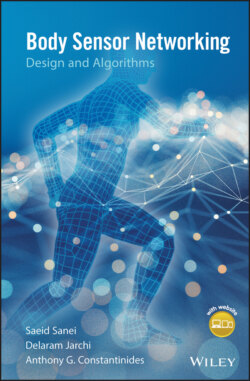Читать книгу Body Sensor Networking, Design and Algorithms - Saeid Sanei - Страница 34
3.3.1 Multichannel Measurement of the Nerves Electric Potentials
ОглавлениеElectroencephalography (EEG), EMG, and electrocardiography (ECG) are probably the most common types of physiological measurement systems. They are widely available in the related clinical departments. In terms of operations, they measure, respectively, the electrical activities of nerves in the brain, muscles, and heart. Technically, low-noise differential amplifiers, with high amplification gains and large input impedance, are used to capture tiny variations in the voltage between each two electrodes or with respect to a common reference over the body. A typical three-stage differential amplifier is depicted in Section 3.5. Fundamental electronic components, such as operational amplifiers, resistors, capacitors, and diodes, are used to make this device. EEG and ECG (or even EMG) often involve a large number of channels. Nevertheless, due to their low bandwidth, the signals are often sampled in a low rate, which makes their real-time processing possible (Figure 3.4).
The EEG systems with their electrodes mounted over the cortex are called electrocorticography (ECoG) systems and those for measuring deep brain signals from deeper areas of the brain, are called intracranial EEG. In some applications, such as recording the neuron activities from the hippocampus, the measurement can be done by using multichannel electrodes inserted through human foramen ovale holes from both sides of the face. Figure 3.5a and b shows an ECoG and foramen ovale (FO) implant for deep brain source measurements.
Figure 3.4 A simple EEG differential amplifier used in EEG or EMG systems.
As another brain scanning modality, magnetoencephalography (MEG) is used to measure the magnetic fields produced by the electric currents in the brain. MEG and EEG look very similar. The advantage of MEG over EEG is its insensitivity against the changes in the tissue density, so it can be effectively used for more accurate brain source localisation. However, the system is complex, bulky, expensive, and not easily available for long-term patient monitoring, and requires a high maintenance cost.
ECG (also called EKG) is used to measure the electrical activity of the heart muscle nerves. The activity stems from pumping the blood through the right supraventricular down into the right ventricle and circling upward from the left ventricle to the left supraventricular and pumping into the arteries. Often 10–14 electrodes are used with reference to the arm, wrist or foot to capture the state of different heart sections.
The systems for measuring electrical activity of the body don't involve any time delay and therefore processing of EEG, MEG, EMG, and ECG doesn't suffer any fading, clutter, or time overlapping of the signals. On the other hand, the effective frequency range falls below 500 Hz, which requires low processing power and bandwidth.
There have been efforts to miniaturise these sensors with wireless capability. As an example, Figure 3.6 shows a new patch type ECG system which includes wireless connection to remote devices.
On the other hand, heart and lung sounds can be heard and recorded using electronic stethoscopes. They are sensitive microphones isolated from the surrounding environment when placed on the skin around the heart or back side of the body, so the ambient noise is greatly reduced. Most heart abnormalities as well as problems in the lung which cause wheezing or crackling can be easily heard and recorded through these systems. In some recent models, such as Modell 3200 by the Littman company (Figure 3.7), the stethoscope can also transmit sound signals via Bluetooth to the remote device for observation, archiving, and analysis.
Figure 3.5 (a) ECoG and (b) foramen ovale electrodes denoted by pointers. In this setup, a scalp EEG has also been used. (See color plate section for color representation of this figure)
One of the challenging problems in assessing the recorded stethoscope data is separation of heart and lung sounds for automatic diagnosis. The difficulty stems from the fact that sound signals are subject to delay and for their separation a robust convolutive source separation technique is required. Although many solutions have been proposed by signal processing researchers [37–40], design of a clinically usable system which can effectively separate these two sound signals is still being researched.
Figure 3.6 New patch type ECG systems including electrodes and wireless connection.
